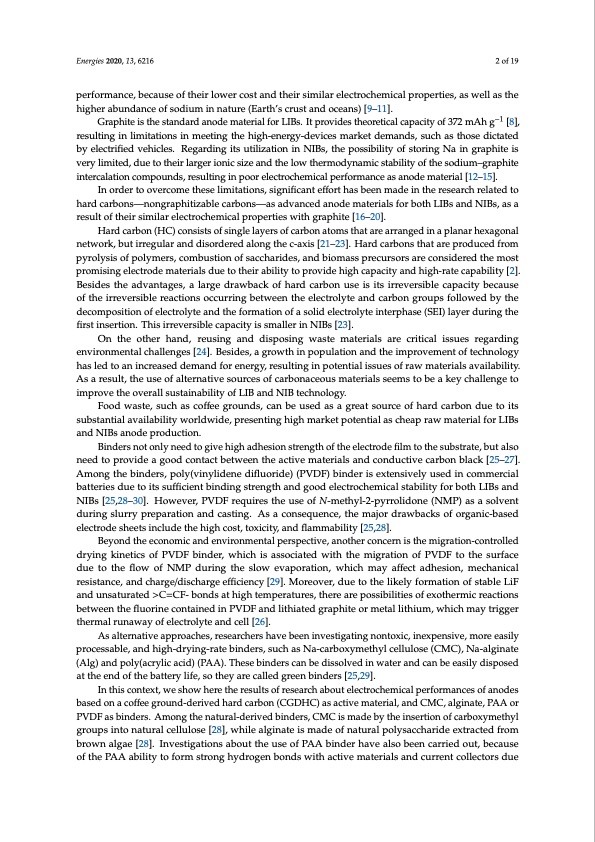
PDF Publication Title:
Text from PDF Page: 002
Energies 2020, 13, 6216 2 of 19 performance, because of their lower cost and their similar electrochemical properties, as well as the higher abundance of sodium in nature (Earth’s crust and oceans) [9–11]. Graphite is the standard anode material for LIBs. It provides theoretical capacity of 372 mAh g−1 [8], resulting in limitations in meeting the high-energy-devices market demands, such as those dictated by electrified vehicles. Regarding its utilization in NIBs, the possibility of storing Na in graphite is very limited, due to their larger ionic size and the low thermodynamic stability of the sodium–graphite intercalation compounds, resulting in poor electrochemical performance as anode material [12–15]. In order to overcome these limitations, significant effort has been made in the research related to hard carbons—nongraphitizable carbons—as advanced anode materials for both LIBs and NIBs, as a result of their similar electrochemical properties with graphite [16–20]. Hard carbon (HC) consists of single layers of carbon atoms that are arranged in a planar hexagonal network, but irregular and disordered along the c-axis [21–23]. Hard carbons that are produced from pyrolysis of polymers, combustion of saccharides, and biomass precursors are considered the most promising electrode materials due to their ability to provide high capacity and high-rate capability [2]. Besides the advantages, a large drawback of hard carbon use is its irreversible capacity because of the irreversible reactions occurring between the electrolyte and carbon groups followed by the decomposition of electrolyte and the formation of a solid electrolyte interphase (SEI) layer during the first insertion. This irreversible capacity is smaller in NIBs [23]. On the other hand, reusing and disposing waste materials are critical issues regarding environmental challenges [24]. Besides, a growth in population and the improvement of technology has led to an increased demand for energy, resulting in potential issues of raw materials availability. As a result, the use of alternative sources of carbonaceous materials seems to be a key challenge to improve the overall sustainability of LIB and NIB technology. Food waste, such as coffee grounds, can be used as a great source of hard carbon due to its substantial availability worldwide, presenting high market potential as cheap raw material for LIBs and NIBs anode production. Binders not only need to give high adhesion strength of the electrode film to the substrate, but also need to provide a good contact between the active materials and conductive carbon black [25–27]. Among the binders, poly(vinylidene difluoride) (PVDF) binder is extensively used in commercial batteries due to its sufficient binding strength and good electrochemical stability for both LIBs and NIBs [25,28–30]. However, PVDF requires the use of N-methyl-2-pyrrolidone (NMP) as a solvent during slurry preparation and casting. As a consequence, the major drawbacks of organic-based electrode sheets include the high cost, toxicity, and flammability [25,28]. Beyond the economic and environmental perspective, another concern is the migration-controlled drying kinetics of PVDF binder, which is associated with the migration of PVDF to the surface due to the flow of NMP during the slow evaporation, which may affect adhesion, mechanical resistance, and charge/discharge efficiency [29]. Moreover, due to the likely formation of stable LiF and unsaturated >C=CF- bonds at high temperatures, there are possibilities of exothermic reactions between the fluorine contained in PVDF and lithiated graphite or metal lithium, which may trigger thermal runaway of electrolyte and cell [26]. As alternative approaches, researchers have been investigating nontoxic, inexpensive, more easily processable, and high-drying-rate binders, such as Na-carboxymethyl cellulose (CMC), Na-alginate (Alg) and poly(acrylic acid) (PAA). These binders can be dissolved in water and can be easily disposed at the end of the battery life, so they are called green binders [25,29]. In this context, we show here the results of research about electrochemical performances of anodes based on a coffee ground-derived hard carbon (CGDHC) as active material, and CMC, alginate, PAA or PVDF as binders. Among the natural-derived binders, CMC is made by the insertion of carboxymethyl groups into natural cellulose [28], while alginate is made of natural polysaccharide extracted from brown algae [28]. Investigations about the use of PAA binder have also been carried out, because of the PAA ability to form strong hydrogen bonds with active materials and current collectors duePDF Image | Coffee Ground Sustainable Anodes Sodium-Ion Batteries

PDF Search Title:
Coffee Ground Sustainable Anodes Sodium-Ion BatteriesOriginal File Name Searched:
energies-13-06216.pdfDIY PDF Search: Google It | Yahoo | Bing
Salgenx Redox Flow Battery Technology: Salt water flow battery technology with low cost and great energy density that can be used for power storage and thermal storage. Let us de-risk your production using our license. Our aqueous flow battery is less cost than Tesla Megapack and available faster. Redox flow battery. No membrane needed like with Vanadium, or Bromine. Salgenx flow battery
| CONTACT TEL: 608-238-6001 Email: greg@salgenx.com | RSS | AMP |